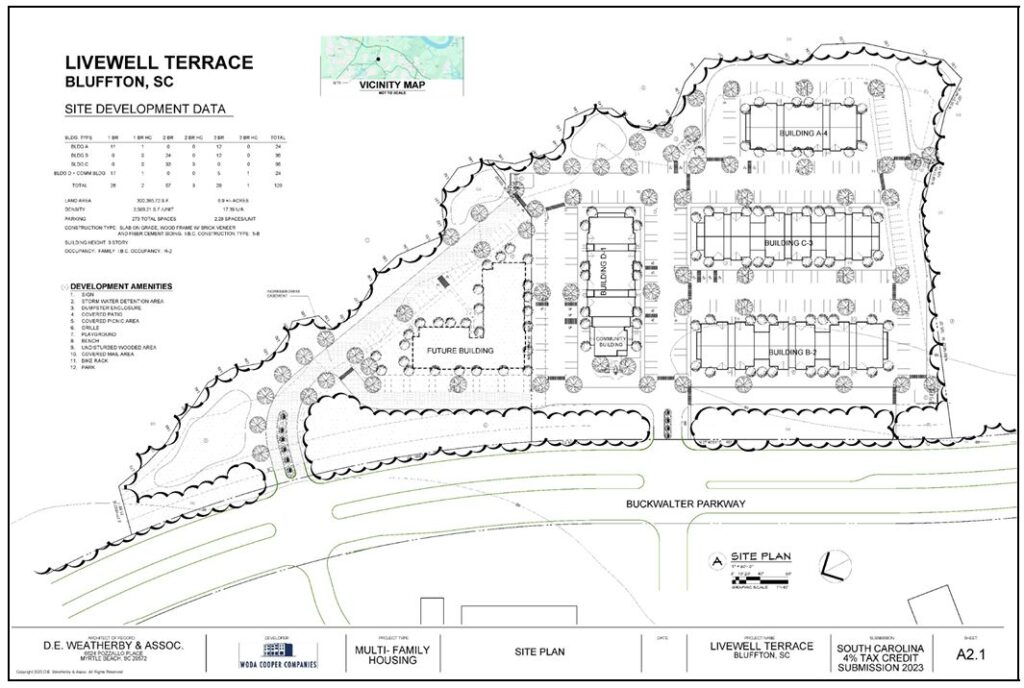Healthcare Enters the Affordable Housing Business
Hospitals Turn to Developers to Help Alleviate Workforce Shortages

By Ethan Finlan
5 min read
Workforce housing projects—rent-restricted housing geared specifically at local industry employees—have long been a priority of numerous housing financing agencies across America. An oft-discussed form of workforce housing is when the employers build the housing themselves. One case study is unfolding in eastern South Carolina, near Hilton Head Island, where Beaufort Memorial Hospital (BMH) has partnered with a nationwide affordable housing developer to build an affordable housing complex its employees will be able to take advantage of in the future.

The region’s increasing cost of living and demand motivated BMH’s interest. “The lack of affordable housing in Beaufort County has reached a ‘crisis’ level from our workforce,” Beaufort Memorial President and CEO Russell Baxley says. The median home price in Bluffton grew 2.4 percent from 2023 to 2024, sitting at $507,320, and 5.1 percent in nearby Beaufort, speaking to the reality of America’s housing affordability crisis reaching the long-affordable Sunbelt. Matt McColl with SC Housing states that projections estimate the county will house over 195,500 residents in two years.
Retirees account for some of the population growth, Baxley adds, and “[t]he growth is exponentially increasing the need for our services (and staff to provide that care) while adding to the high demand for housing.”

McColl echoes this sentiment. “Workforce housing demand in South Carolina is driven by rapid population growth,” he says, “especially in the coastal, upstate and midlands regions, where nearly 90 percent of the state’s residents live.”
The affordability problems began to impact recruitment for BMH. “The healthcare industry is full of many types of jobs, from clinical positions to nutrition and hospitality services and everything in between,” says Baxley, “and all have expressed frustration at the cost of living here.”
As such, BMH began assessing strategies to increase its staff’s access to affordable housing and decided to partner with Beaufort County and the Town of Bluffton to develop a new complex, called Livewell Terrace Apartments by BMH on a parcel it located, says Parker Zee, vice president of Woda Cooper Companies, the Ohio-based firm building the project. Baxley notes that the hospital leaned on Woda Cooper to cover the development side of the business, as the hospital had no prior experience in building housing.

But BMH otherwise spearheaded efforts, Zee says, starting the discussions with local officials, taking an active role in the planning process, and persuading the community that Livewell Terrace was a worthwhile project. “[E]ven though they don’t have a background in housing, their experience developing hospitals and other medical uses in Bluffton and Beaufort County has provided helpful insights as we continue working through the entitlement process,” Zee adds.
The firm then engaged with the state, providing a demand assessment in late 2023, which found the development could expect a six- to nine-month lease-up period. The project was allocated tax-exempt bonds in the Summer of 2024, according to Woda Cooper.
The completed project will have 120 units, alongside a 5,000-square-foot expansion of the company’s medical office services. “It’s a win-win; the community will see the addition of needed medical facilities and a boost in affordable housing options.” While the project is geared toward BMH workers, anyone can apply for an apartment. The demand assessment states that it is close to several retail options. Zee says Woda Cooper is working with BMH to guarantee an adequate design for the shared use.
Zee also says that Woda Cooper will own and operate Livewell Terrace; Baxley anticipates that the facility will operate under a land-lease arrangement. “BMH [believes] we can help offset the costs of development by acquiring land or using currently owned land for new, affordable multifamily developments,” he says.
South Carolina doesn’t have any funds directed specifically at workforce housing projects on the state level, but it does have a housing trust for “many activities” related to affordable housing, McColl says.
BMH is not the only hospital taking an interest in affordable housing. An article by The Association of American Medical Colleges notes that in addition to numerous hospitals establishing housing programs to aid patients, in Baltimore, Bon Secours Mercy Health built 800 affordable units. Boston Medical Center has financed housing for its patients, particularly the elderly.
And in Florida, Tampa General Hospital has launched a $60 million affordable housing development project. The hospital, which plans a complex in the city of Brandon, was also motivated by increasing housing costs.
Beyond healthcare, several other industries are also turning to workforce housing construction. Disney is undertaking a large-scale project in Florida in which the majority of 1,400 units will be affordable, while Tesla plans a Texas project with units rent starting at $800.
McColl is unaware of any similar projects elsewhere in South Carolina. But BMH hopes to develop more such projects “in multiple locations,” Baxley says. Adding that the hospital believes it can “offset the cost” of Livewell Terrace by pursuing additional projects. Currently, the hospital and Woda Cooper are exploring a site in Okatie, which Baxley expects to start within the next few years.

For his part, Zee says that Woda Cooper is open to pursuing future institutional partnerships and continuing its partnership with BMH on future projects. It recently completed a Columbus development in partnership with an affiliate of Nationwide Children’s Hospital and will proceed with a Michigan project in partnership with a healthcare company, having received a tax credit allocation. BMH is motivated to keep pursuing affordable housing as a means of dealing with the county’s housing shortage but believes partnerships are essential for accomplishing this goal.
“The county alone can’t solve this issue,” Baxley concludes. “[I]t requires innovation, dedication and collaboration, plus a cohesive vision to identify solutions. No single organization or entity can do it all by themselves.”